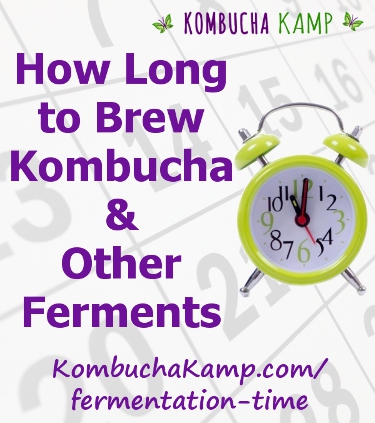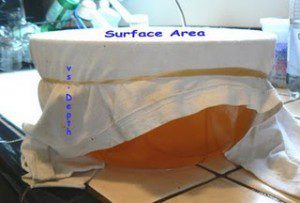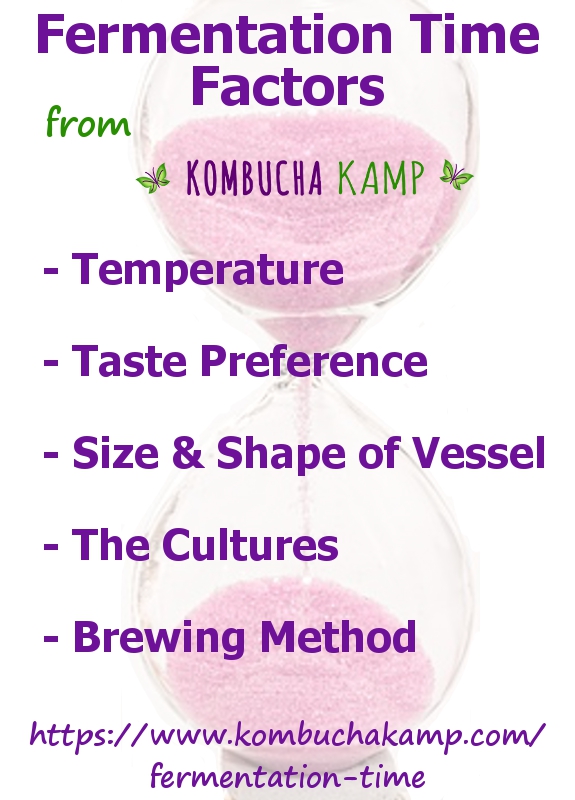
How Long To Brew Kombucha – Fermentation Time
 We get a lot of questions asking how long to brew Kombucha. The answer is it varies!
We get a lot of questions asking how long to brew Kombucha. The answer is it varies!
But in general, most people brew a one gallon batch of Kombucha for 7-21 days.
That’s a pretty wide range right!? Either 7 days…or 3 times that amount? So why does the amount of time to ferment Kombucha change?
This is an excellent question and the answer depends on you and your environment. Not to mention whether you are doing Batch Brew or the Continuous Brew method.
Fermentation Time Factors
Let’s look at the factors that influence how long to brew Kombucha or any home ferment such as JUN, milk kefir, or water kefir.
- Temperature
- Taste Preference
- Size & Shape of Vessel
- The Cultures
- Brewing Method
How Long To Brew Kombucha
and Other Home Ferments
Quick Reference Chart
| Ferment | Size | Time Range | Average |
| Kombucha Batch Brew | 1 Gallon (4 liters) | 7-21 days | 10 days |
| “ | 2 Gallon (8 liters) | 10-30 days | 15 days |
| Kombucha Continuous Brew First Batch | 2.5 Gallon Vessel (10 liters) | 10-30 days | 15 days |
| “ | 5 Gallon Vessel (20 liters) | 18-42 days | 21 days |
| Kombucha Continuous Brew Sweet Tea Refill | 1 Gallon (4 liters) | 1-5 days | 3 days |
| Water Kefir | 1 Quart (1 liter) | 1-4 days | 2 days |
| Milk Kefir | 1 Pint (½ liter) | 12-48 hours | 24 hours |
*for JUN, which brews a little faster,
reduce the listed Kombucha time ranges by roughly 3-7 days.
1. Temperature
The hotter the temperature, the faster the ferment. Conversely, the cooler the temperature, the slower the ferment.
If you’re wondering “Why is my Kombucha not fermenting fast enough?”, the most common answer is the temperature is too low.
That said, some ferments require more specific temperature ranges and others are more flexible. The ideal temperature range for fermenting Kombucha is 75-85°F (24-30°C).
CLICK HERE to learn Ideal Temperature Ranges for all your Home Ferments
We like it sour, so in the Summer our Kombucha brewing time is anywhere from 10-12 days for a gallon, whereas in the Winter it can be 2 weeks or longer, even when using a heating mat.
Here in southern California, we find it necessary almost year round to add a little heat to the brew.
CLICK HERE for Winter Brewing Tips
2. Taste Preference
This is the most important deciding factor. For those that are new to brewing, we recommend tasting the Kombucha after 7 days of fermenting. Simply insert a straw under your SCOBY and take a sip.
Is the Kombucha too sweet? Too sour? Not tart enough? You are the ultimate decider in how long to brew Kombucha. What tastes delicious to you? And your taste will evolve the longer you brew.
We’ve also discovered that over time we are better able to sense when the Kombucha is ready based on how the weather has been, the date it was brewed, etc.
*Note – It’s a Kombucha Myth that pH will indicate the brew is ready. Proper pH is an indication that your Kombucha brew is uncontaminated and progressing safely. But only your taste buds can tell you if the brew is ready to harvest. CLICK HERE to learn more about Kombucha pH.
Troubleshooting Taste
How To Fix the Flavor of the Kombucha Brew
As long as there is no mold on top of the brew, there is no health issue with fermenting Kombucha too long.
The problem is it doesn’t taste good!
Kombucha Too Sour?
There are a couple of things you can do to improve the taste of slightly over fermented Kombucha.
- Mix some less mature Kombucha with the sour Kombucha to even out the flavor
- Dilute with water or juice (THRIVE , AMZ)
- Flavor with anything you like, the type of flavoring will impact the sourness over time. For example, chai spice can mellow the flavor. Similarly flowers such as chamomile and lavender can make for a smoother taste. They are not miracle workers! You can’t take a vinegary brew and hope to make it sweet again. But if it’s just a little too sour, these flavors might help.
*Note: Once you found the flavor you like, stick it in the fridge. The drop in temperature will slow down the fermentation process.
Common Question: Can I add sugar to sour Kombucha? The answer is yes you can, but beware. Adding sugar will restart the fermentation process. That sugar becomes fuel for the creation of more acids. So adding sugar to a sour brew actually creates a more sour brew over time. In fact, that’s how you create Kombucha vinegar!
Kombucha Fermenting Too Fast?
If your Kombucha is consistently too sour, even after brewing for fewer days, consider adjusting the recipe. For the next batch, use less tea or steep for a shorter time. You could also use ¾ of a cup of sugar rather than the full cup. Both of these steps decrease the amount of fuel for creating acids in the drink, so a smoother flavor will likely be the result.
Other ways to slow down the pace of the brew: lower temperatures, use less SCOBY and starter liquid, harvest sooner, use a taller and thinner vessel.
If the flavor is still too intense, here are some uses for over fermented Kombucha (aka Kombucha vinegar).
Kombucha Too Sweet?
If it’s too sweet, allow your Kombucha to continue to ferment. Consider adding some heat. If after 21-30 days your Kombucha is still too sweet, then the culture may have fallen dormant and likely needs to be replaced with a fresh Kombucha SCOBY.
Secondary Fermentation
If you enjoy the secondary fermentation process, and also hope to build up some carbonation in your Kombucha, consider harvesting the brew a little sooner in the process, when it’s a touch sweeter than you like. to be as tart since it will be fermenting a little longer – however, the addition of sugar (from the fruit or ginger,etc) will also add a little sweetness.
Keep a brewing log to record the date of brew for each batch. This is especially helpful if you have multiple batches going at one time. A Brewing Log is included with our FREE DIY Brewing Guide, that comes when you sign up for the newsletter at the end of this post.
3. Size and Shape of Vessel
There is a bit of physics that goes into brewing Kombucha. The new layer of SCOBY forming on top of the brew will always always grow across the top in an attempt to create a seal.
If using a typical gallon jar suitable for brewing, they are just a bit more tall than wide. Therefore the width (surface area) is less than the depth of the vessel. The Kombucha will ferment more slowly because there is less surface area to depth, meaning the brew is deeper.
If we ferment in a large glass bowl (AMZ)with a really wide mouth, the width is greater than the depth of the vessel, providing greater surface area. The same gallon will ferment a bit faster because the brew is shallower.

That said, a large bowl like this is really inconvenient and not recommended for a variety of reasons!
CLICK HERE to learn how to select the right vessel (and spigot) for your Kombucha
Using a larger vessel, such as one for Continuous Brew, will also affect how long to ferment Kombucha. The more sweet tea present, the longer it will take to ferment. (CB cuts down on that – more below)
4. The Cultures – How Strong and How Much
With home ferments, the quality and health of the cultures is where it all starts. An unhealthy culture will never produce the brew you desire.
It may be possible to bring some cultures back to health. With Kombucha and JUN, that usually means resting them in some sweet tea and mature liquid. For kefir grains, it generally means feeding them more regularly.
Rather than have to recover damaged cultures, start with quality and maintain them properly.
CLICK HERE for the 5 Signs of a Healthy Kombucha Brew
SCOBY Source?
But beware! Not all Kombucha SCOBYs, JUN Cultures, or Kefir Grains are the same. Starting with contaminated or weak cultures is more common than people know.
For one, dehydrated SCOBYs as offered by some retailers are never recommended. Fresh Live Cultures are always a superior choice.
And while it is wonderful to receive a culture from a friend, family member, or someone online, free cultures can be hit or miss when it comes to quality. Vinegar eels, weak/old SCOBYs, refrigerated cultures, and not enough liquid are just a few of the common problems.
For that matter there are a number of seemingly reputable sellers online that offer miniature cultures, not enough starter liquid, poorly performing dehydrated cultures, or other culture contamination problems.
Bottom line: Make sure you can trust the person or company supplying your cultures. With KKamp, you can always Trust Your Gut! 🙂
How Many SCOBYs?
Leaving a lot of SCOBYs in the brew will also shorten how long it takes to brew Kombucha. This can be good or bad, but always depending on flavor.
In Continuous Brew (more below), we leave a large amount of SCOBY and liquid in the vessel. Because the vessel is very large, this can be done without ruining the brew.
However, with Batch Brew in a one gallon container, leaving too much SCOBY or old liquid in the brew results in imbalance and terrible flavor. This is one reason Continuous Brew is recommended for larger vessels only.
CLICK HERE for more about Reducing and Trimming SCOBYs in Your Brew
In general for a Batch Brew, 2 large SCOBYs per gallon is the most recommended to start with. Starter liquid can range from 1-4 cups per gallon, depending on the strength.
With Continuous Brew, we’re only worried about the flavor. So as long as we like what’s coming out of the tap, we can leave the SCOBYs in the vessel alone. Every 2-6 months, it will be time for basic maintenance.
5. Brewing Method
As you may already know, Continuous Brew is the best method for making more Kombucha (or JUN) more quickly. That’s because the large amount of mature liquid and SCOBY in the vessel cuts down on the time needed for brewing. Plus the pH never rises out of the safe zone, even right after sweet tea is added. That speeds the brewing process greatly.
For example, a fully mature CB with a gallon of sour Kombucha and plenty of SCOBY may only require 2-3 days to ferment a gallon of sweet tea and be ready to enjoy. At most, a gallon of sweet tea might take 4-5 days to ferment in a mature Continuous Brew set up. Compare that to an average of 10-12 days for Batch Brewing.
It also means Kombucha mold is not happening in a healthy CB. 🙂
Acids Expression in Continuous Brew
Research indicates that certain acids and other elements aren’t expressed in the Kombucha fermentation process until around the 30 day mark. However, in most brewing situations, a batch at 30 days would be undrinkable and taste like vinegar.
You could choose to brew some young Kombucha, harvested around 7 days, and some more mature Kombucha, harvested around 30 days, and then mix them. But obviously, that’s not particularly convenient.
However, getting a mix of old and young Kombucha is an automatic side benefit of the CB process, which is why many people prefer Continuous Brew Kombucha.
CLICK HERE for more differences between Continuous Brew and Batch Brew Kombucha
In the end, it really is up to you how long to brew Kombucha. The more times you engage in the process, the more intuitive home brewing will become.
Happy Brewing!


